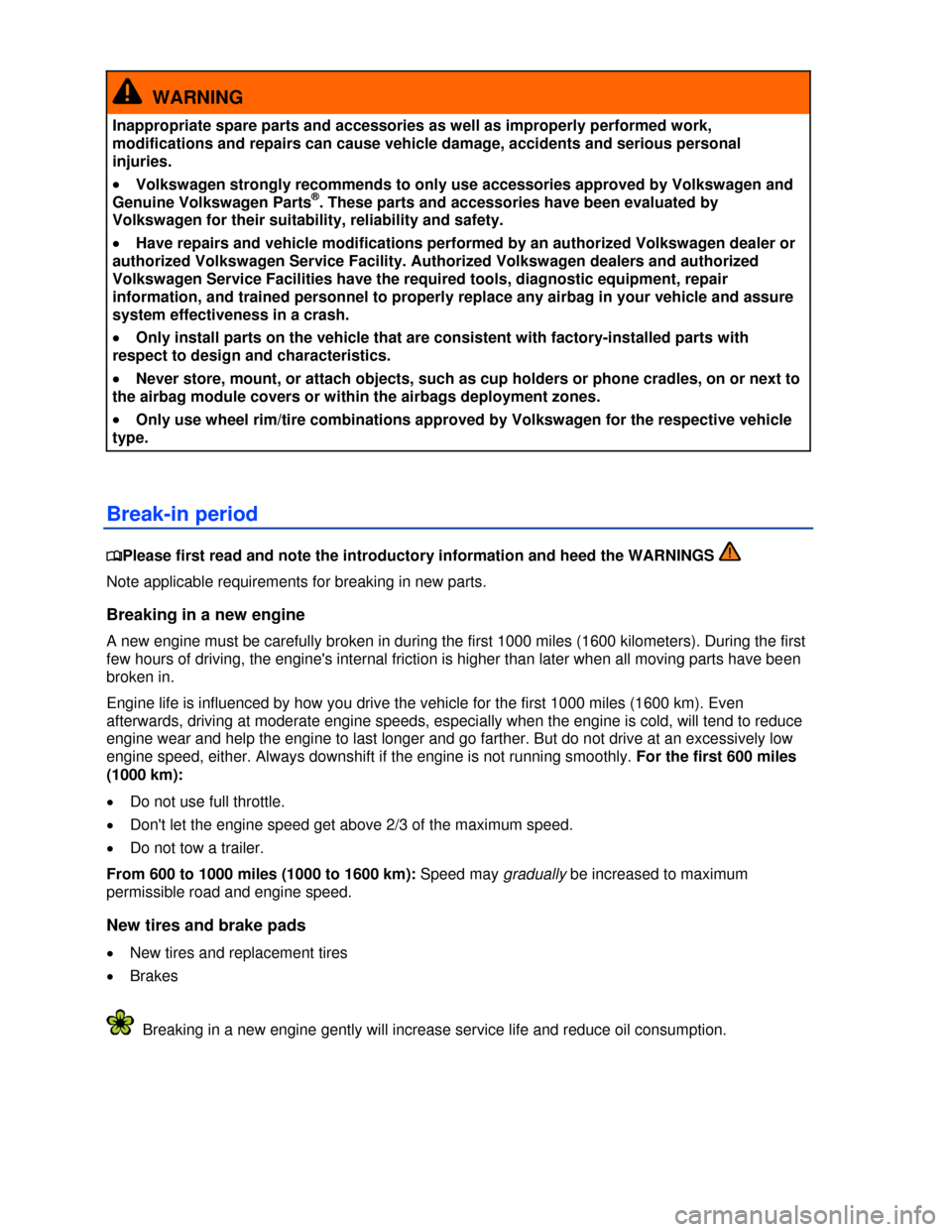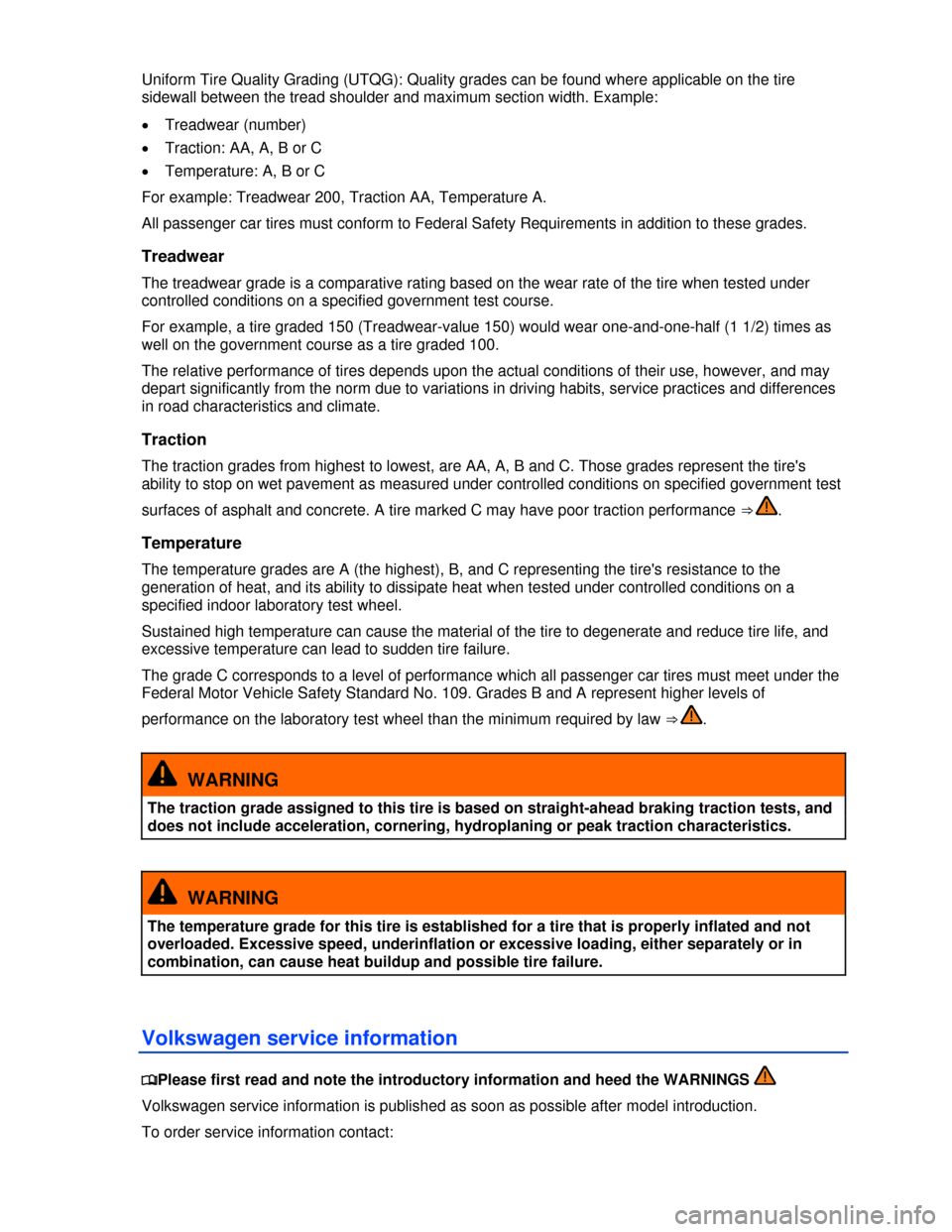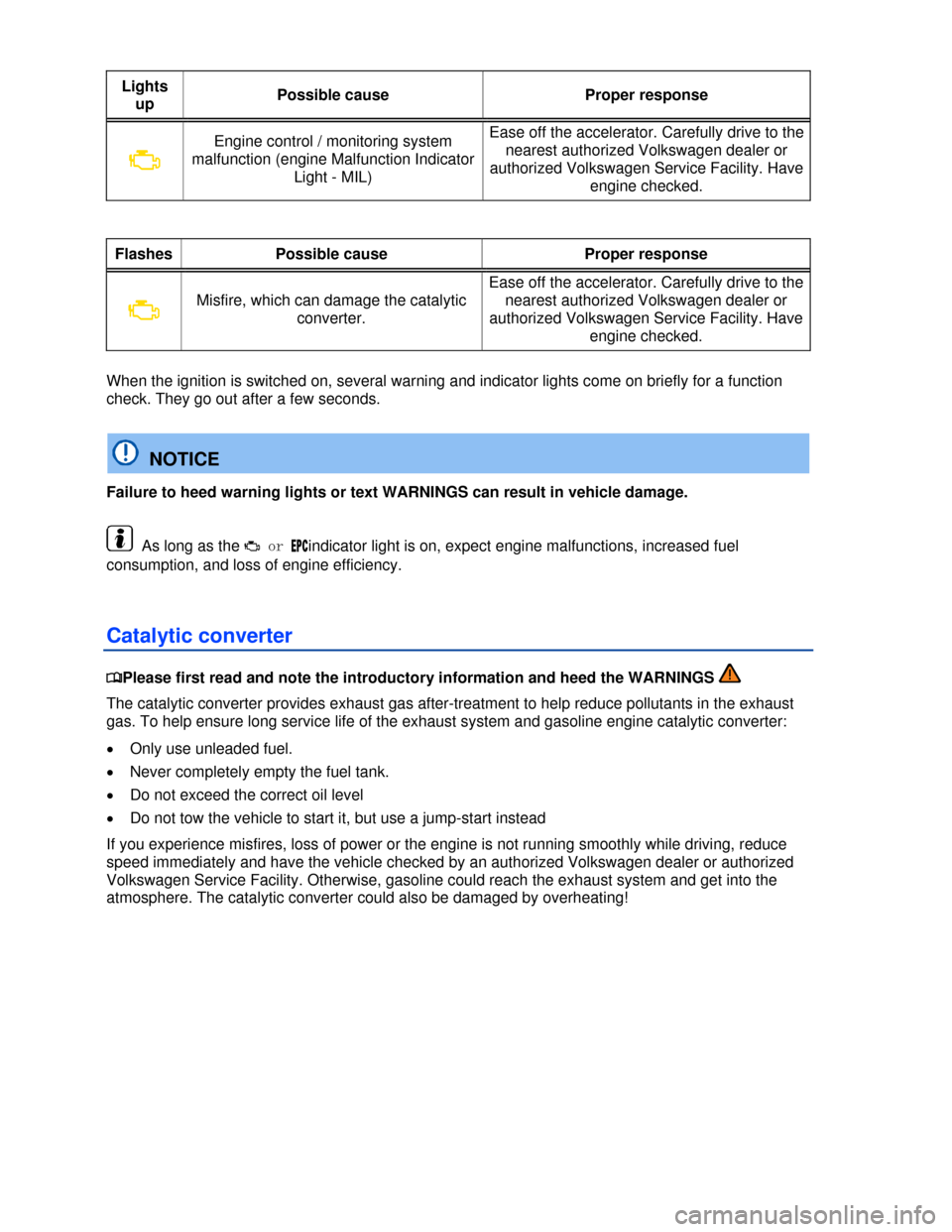2013 VOLKSWAGEN EOS service
[x] Cancel search: servicePage 267 of 329

Tire labeling (example) Meaning
E4 ... Labeling according to international regulations (E) including
number of the approving country. The multi-digit approval number
is listed next.
DOT BT RA TY5 1709 Tire identification number (TIN)6 – In some cases the
manufacturing date is only on one side of the tire:
DOT The tire complies with the requirements of the United
States Department of Transportation, responsible for
issuing safety standards.
BT Identification letter of the manufacturing site.
RA Manufacturer information regarding tire dimensions.
TY5 Tire characteristics provided by the manufacturer.
1709 Manufacturing date: 17th week in 2009.
TWI Marks the position of the treadwear indicator ⇒ fig. 162.
Made in Germany Country of manufacture.
MAX LOAD 615 KG (1356 LBS) United States maximum load rating per wheel.
MAX INFLATION 350 KPA
(51 PSI)
United States maximum permissible inflation pressure.
ROTATION Rotation direction (unidirectional tires)
SIDEWALL 1 PLY RAYON Tire ply composition and materials used:
1 layer of rayon.
TREAD 4 PLIES
1 RAYON + 2 STEEL +
1 NYLON
Tire tread composition and materials used:
In this example there are 4 layers under the tread: 1 layer of
rayon, 2 layers of steel belt and 1 layer of nylon.
Consumer information regarding comparison to specified base tires (standardized test
procedure)
TREADWEAR 220 Relative service life expectancy of the tire referenced to a U.S.-
specific standard test.
TRACTION A Traction rating under wet conditions (AA, A, B or C).
TEMPERATURE A Temperature stability of the tire at increased test bench speeds
(A, B or C).
Additional numbers found on the tire could either be tire manufacturer internal labels or
country-specific labels (such as for Brazil and China).
Unidirectional tires
Unidirectional tires are designed to rotate only in one direction. Unidirectional tires have arrows on the
sidewalls that show the direction of rotation. Make sure you mount the tire so that it rotates in the
proper direction. The tire's performance with regard to hydroplaning, traction, noise, and wear is worse
if it is not mounted in the proper direction of rotation.
If you have to mount a tire opposite to its proper direction of rotation, you must drive more carefully,
since the tire is no longer being used as designed. This is particularly important on wet roads. You
must replace or remount the tire as soon as possible in order to restore the correct direction of
rotation.
6 TIN represents the serial number of the tire.
Page 270 of 329

WARNING
Driving faster than the maximum speed for which the winter tires on your vehicle were
designed can cause sudden tire failure including a blowout and sudden deflation, loss of
control, crashes and serious personal injuries.
�x Winter tires have a maximum speed rating that may be lower than your vehicle's maximum
speed.
�x Never drive faster than the maximum speed for which the winter tires installed on your
vehicle are rated because tires that are driven faster than their rated speed can fail suddenly.
�x Never exceed the maximum load rating for the winter tires installed on your vehicle.
Install summer tires promptly in the spring. Summer tires offer better handling characteristics for
temperatures above +45 °F (+7 °C). They are quieter, do not wear as quickly, and reduce fuel
consumption.
If factory-installed wheels and/or tires are replaced when installing winter tires, make sure that
the tires are equipped with sensors that are compatible with the factory-installed Tire Pressure
Monitoring System and with the wheels Error! Bookmark not defined., New and replacement tires,
228The Tire Pressure Monitoring System must be recalibrated using the SET button whenever you
remove and remount or change any wheel or tire on the vehicle, even if the reinstalled or replacement
wheels and tires are identical to those that were removed and even if the tire pressure does not
change 231.
If necessary, ask your authorized Volkswagen dealer or authorized Volkswagen Service Facility
about permissible winter tire dimensions.
Snow chains
�
Page 278 of 329

WARNING
Inappropriate spare parts and accessories as well as improperly performed work,
modifications and repairs can cause vehicle damage, accidents and serious personal
injuries.
�x Volkswagen strongly recommends to only use accessories approved by Volkswagen and
Genuine Volkswagen Parts®. These parts and accessories have been evaluated by
Volkswagen for their suitability, reliability and safety.
�x Have repairs and vehicle modifications performed by an authorized Volkswagen dealer or
authorized Volkswagen Service Facility. Authorized Volkswagen dealers and authorized
Volkswagen Service Facilities have the required tools, diagnostic equipment, repair
information, and trained personnel to properly replace any airbag in your vehicle and assure
system effectiveness in a crash.
�x Only install parts on the vehicle that are consistent with factory-installed parts with
respect to design and characteristics.
�x Never store, mount, or attach objects, such as cup holders or phone cradles, on or next to
the airbag module covers or within the airbags deployment zones.
�x Only use wheel rim/tire combinations approved by Volkswagen for the respective vehicle
type.
Break-in period
�
Page 285 of 329

Uniform Tire Quality Grading (UTQG): Quality grades can be found where applicable on the tire
sidewall between the tread shoulder and maximum section width. Example:
�x Treadwear (number)
�x Traction: AA, A, B or C
�x Temperature: A, B or C
For example: Treadwear 200, Traction AA, Temperature A.
All passenger car tires must conform to Federal Safety Requirements in addition to these grades.
Treadwear
The treadwear grade is a comparative rating based on the wear rate of the tire when tested under
controlled conditions on a specified government test course.
For example, a tire graded 150 (Treadwear-value 150) would wear one-and-one-half (1 1/2) times as
well on the government course as a tire graded 100.
The relative performance of tires depends upon the actual conditions of their use, however, and may
depart significantly from the norm due to variations in driving habits, service practices and differences
in road characteristics and climate.
Traction
The traction grades from highest to lowest, are AA, A, B and C. Those grades represent the tire's
ability to stop on wet pavement as measured under controlled conditions on specified government test
surfaces of asphalt and concrete. A tire marked C may have poor traction performance ⇒ .
Temperature
The temperature grades are A (the highest), B, and C representing the tire's resistance to the
generation of heat, and its ability to dissipate heat when tested under controlled conditions on a
specified indoor laboratory test wheel.
Sustained high temperature can cause the material of the tire to degenerate and reduce tire life, and
excessive temperature can lead to sudden tire failure.
The grade C corresponds to a level of performance which all passenger car tires must meet under the
Federal Motor Vehicle Safety Standard No. 109. Grades B and A represent higher levels of
performance on the laboratory test wheel than the minimum required by law ⇒ .
WARNING
The traction grade assigned to this tire is based on straight-ahead braking traction tests, and
does not include acceleration, cornering, hydroplaning or peak traction characteristics.
WARNING
The temperature grade for this tire is established for a tire that is properly inflated and not
overloaded. Excessive speed, underinflation or excessive loading, either separately or in
combination, can cause heat buildup and possible tire failure.
Volkswagen service information
�
Page 286 of 329

Volkswagen Technical Literature Ordering Center
www.vw.techliterature.com
WARNING
Improperly performed repairs and modifications can cause vehicle damage and malfunctions,
and can impair the efficiency of driver assistance systems and the airbag system. This can
lead to accidents and severe personal injuries.
�x Have repairs and vehicle modifications performed by an authorized Volkswagen dealer or
an authorized Volkswagen Service Facility.
Page 290 of 329

Lights
up Possible cause Proper response
�B
Engine control / monitoring system
malfunction (engine Malfunction Indicator
Light - MIL)
Ease off the accelerator. Carefully drive to the
nearest authorized Volkswagen dealer or
authorized Volkswagen Service Facility. Have
engine checked.
Flashes Possible cause Proper response
�B Misfire, which can damage the catalytic
converter.
Ease off the accelerator. Carefully drive to the
nearest authorized Volkswagen dealer or
authorized Volkswagen Service Facility. Have
engine checked.
When the ignition is switched on, several warning and indicator lights come on briefly for a function
check. They go out after a few seconds.
NOTICE
Failure to heed warning lights or text WARNINGS can result in vehicle damage.
As long as the �B or �%�0�#indicator light is on, expect engine malfunctions, increased fuel
consumption, and loss of engine efficiency.
Catalytic converter
�
Page 291 of 329

Frequently asked questions
If you suspect a malfunction or vehicle damage, read and follow the following advice before contacting
an authorized Volkswagen dealer or an authorized Volkswagen Service Facility. You may also find
helpful information under “Special considerations” or “Checklist” in the index.
Description Possible causes, among
others Possible remedy
Engine does not start.
Vehicle battery dead. – Perform jump-start
– Charge vehicle battery
The wrong vehicle key is used. Use a valid vehicle key
Fuel level too low. Refuel
Vehicle cannot be locked
or unlocked using vehicle
key.
– Battery in the remote control
vehicle key is dead.
– Too far away from the
vehicle (out of range).
– Buttons have been pressed
too many times.
– Replace the battery in the remote
control vehicle key
– Move closer to vehicle.
– Synchronize vehicle key
– Lock or unlock vehicle manually
Unusual noises.
Cold engine, braking assist
systems, electronic steering
column lock.
Check the “Noises” entry in the index.
Odd driving behavior.
Assistance systems activated. Check the “Assistance systems” entry
in the index.
DSG® Direct Shift Gearbox too
hot.
Stop vehicle as soon as you can safely
do so.
Outside mirrors move
when the vehicle is
unlocked.
Convenience settings are
stored. Correct convenience settings
Front seats cannot be
adjusted with power
controls.
Vehicle battery dead. Charge vehicle battery
Fuse blown. Check fuse and replace if necessary
CSC roof will not move. CSC roof malfunction.
Check whether any technical
requirement for opening and closing
the CSC roof is not met . If necessary
contact an authorized Volkswagen
dealer or an authorized Volkswagen
Service Facility.
Features do not work as
described in this manual.
Settings were adjusted in the
Volkswagen Information
System.
Check and reset to factory settings if
necessary
Headlights do not light up
the road as they should.
– Headlights incorrectly
adjusted.
– Light bulbs burned out.
– Low beams not switched on.
– Have the headlight range adjusted by
an authorized Volkswagen dealer or an
authorized Volkswagen Service
Facility.
– Change light bulbs
– Switch on low beams .
Electrical consumers do
not work.
Vehicle battery charge too low. Charge vehicle battery .
Remaining fuel level too low. Refuel
Page 293 of 329

Frequently asked questions
If you suspect a malfunction or vehicle damage, read and follow the following advice before contacting
an authorized Volkswagen dealer or an authorized Volkswagen Service Facility. You may also find
helpful information under “Special considerations” or “Checklist” in the index.
Description Possible causes, among
others Possible remedy
Engine does not start.
Vehicle battery dead. – Perform jump-start
– Charge vehicle battery
The wrong vehicle key is used. Use a valid vehicle key
Fuel level too low. Refuel
Vehicle cannot be locked
or unlocked using vehicle
key.
– Battery in the remote control
vehicle key is dead.
– Too far away from the
vehicle (out of range).
– Buttons have been pressed
too many times.
– Replace the battery in the remote
control vehicle key
– Move closer to vehicle.
– Synchronize vehicle key
– Lock or unlock vehicle manually
Unusual noises.
Cold engine, braking assist
systems, electronic steering
column lock.
Check the “Noises” entry in the index.
Odd driving behavior.
Assistance systems activated. Check the “Assistance systems” entry
in the index.
DSG® Direct Shift Gearbox too
hot.
Stop vehicle as soon as you can safely
do so.
Outside mirrors move
when the vehicle is
unlocked.
Convenience settings are
stored. Correct convenience settings
Front seats cannot be
adjusted with power
controls.
Vehicle battery dead. Charge vehicle battery
Fuse blown. Check fuse and replace if necessary
CSC roof will not move. CSC roof malfunction.
Check whether any technical
requirement for opening and closing
the CSC roof is not met . If necessary
contact an authorized Volkswagen
dealer or an authorized Volkswagen
Service Facility.
Features do not work as
described in this manual.
Settings were adjusted in the
Volkswagen Information
System.
Check and reset to factory settings if
necessary
Headlights do not light up
the road as they should.
– Headlights incorrectly
adjusted.
– Light bulbs burned out.
– Low beams not switched on.
– Have the headlight range adjusted by
an authorized Volkswagen dealer or an
authorized Volkswagen Service
Facility.
– Change light bulbs
– Switch on low beams .
Electrical consumers do
not work.
Vehicle battery charge too low. Charge vehicle battery .
Remaining fuel level too low. Refuel